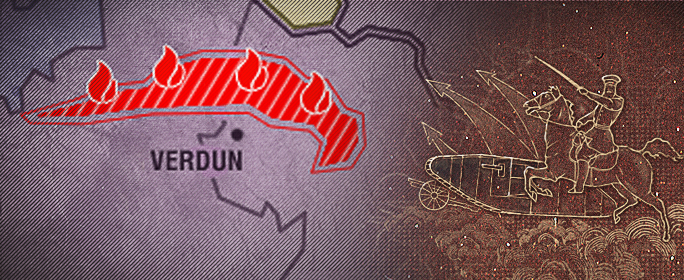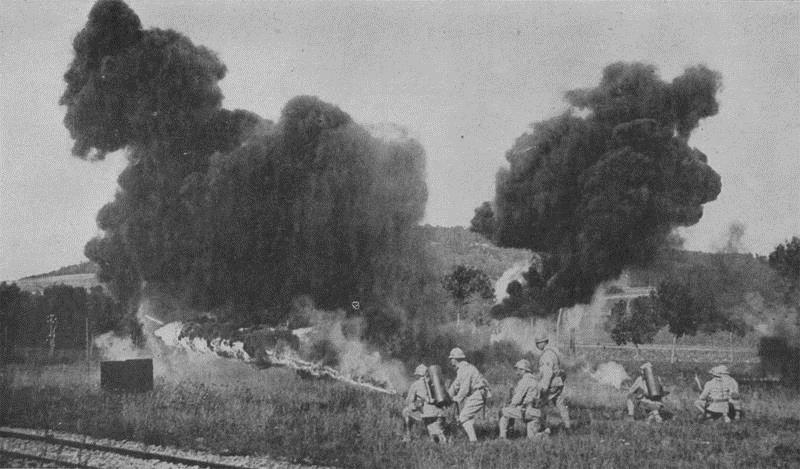
Tankers!
The Battle of Verdun was one of the largest and bloodiest in the First World War. It lasted from February 21 to December 12, 1916 and became known as "Hell of Verdun", hence the name of the Second Stage of the Third Campaign.
Get ready for the next challenge of the Third Campaign on the Global Map -- Hell of Verdun! Below, you'll find the rules and regulations of the Second Stage.
Third Campaign Regulations | Fame Points Rules
General Rules for the Second Stage of the Third Campaign
1.1. The Second Stage of the Third Campaign on the Global Map will be called "Hell of Verdun" and will last 10 days, from November 28 to December 7, 2014.
1.2. Vehicles up to and including tier VIII can take part in this Stage.
1.3. The Map will not be wiped after the First Stage. Province owners will keep their provinces. If they wish to re-land, they'll need to use the "Leave Map" button.
1.4. Starting from November 28, 10:00 PST until November 29 10:00 PST, World Redivision mode will be active:
- All provinces are available for landing.
- All scheduled battles will be canceled, the chips will be returned to the Clan's reserve without cooldown.
- Spies and Counterspies are enabled.
- Revolts and Ransacks are disabled.
- Maximum number of landing applications during World Redivision mode: 32
- If during a landing tournament, a battle with a province owner ends in a draw, the province goes to the attacker.
1.5. World redivision ends on November 29 at 10:00 PST and the Hell of Verdun rules will take effect:
- Revolts and Ransacks are enabled.
- Spies and Counterspies are enabled.
- The maximum number of applications for landing tournaments goes back to 64.
- If during a landing tournament, a battle with a province owner ends in a draw, the province goes to the defender.
1.6. The ability to move chips and attack Fortresses will appear only at the end of World Redivision.
1.7. During the Third Campaign, any Clan may switch between maps or leave the map completely. By leaving the map, a Clan loses all of its provinces on that particular map, but they will retain all of their Fame Points.
1.8. When leaving a map, all of the Clan's chips as well as its Headquarters are removed from the map and go to the Clan's reserve. The chips and Headquarters, withdrawn from the map, will be available after 24 hours. Chips available in reserve may be deployed on the Global Map during the following turn after leaving. Chips on cooldown in a Clan's reserve may be deployed as soon as the cooldown expires.
2. The Main Objective of Hell of Verdun
2.1. During the Second Stage, special areas called Fortresses will appear on the Campaign Map. A Fortress consists of a Citadel in the center and the adjacent Approaches. A Clan gets a Fame Point bonus for capturing Approaches. If a Clan captures a Citadel, then that Citadel’s Approaches will reward a Clan x4 time more Fame Points compared to the standard amount.
2.2. Recapturing the same Approach twice does not bring any bonuses to a Clan. You can find tool tips on the map which will inform you whether you have already captured the Approach or not.
2.3. Provinces directly adjacent to the Approaches are called Bridgeheads and are permanent Landing Provinces.
2.4. The probability of Revolts on the Citadels and their Approaches has been set to 0. The only way to get into Fortress Provinces is via the Bridgeheads.
2.5. The first Fortresses can be attacked after World Redivision.
2.6. Fortresses exist only for five days (120 turns) and then appear elsewhere.
2.7. When a Fortress appears, its Citadel, Approaches and Bridgeheads will be wiped to create equal conditions for all Clans:
- All Chips and Headquarters on these provinces will be transferred to reserve without cooldown.
- If a Clan whose Headquarters has been returned to reserve is performing a Landing Mission, mission progress will be abandoned.
- All Counter-spies on wiped provinces will disappear.
- If a Clan's Headquarters was transferred to reserve, all spies and counter-spies who were in the process of recruitment disappear.
2.8. If a province on which a Citadel or an Approach should appear is a Landing Province, it will be changed to a normal province.
2.9. If a battle for the Bridgehead province ends in a draw, the winner is the defending Clan.
2.10. Fortresses have differing Fame Point values. These differences are marked on the map by icons in different colors - gold, silver, and bronze.
- The Fame Point rewards for a Clan for capturing the Approaches are as follows:
| Fortress type | Citadel Not Captured | Citadel Captured | ||
|---|---|---|---|---|
| Gold | 300,000 FP | 1,200,000 FP | ||
| Silver | 200,000 FP | 800,000 FP | ||
| Bronze | 100,000 FP | 400,000 FP | ||
2.11. Within a single Fortress, all Approaches award the same Fame Point bonus.
2.12. After a Fortress disappears:
- Revolt probability returns to normal
- Scheduled battles for provinces within the Fortress remain scheduled.
- If the Bridgehead province is a Landing Province, the Landing Tournament will remain.
- If the Bridgehead province is a standard province, all scheduled battles are cancelled and all chips are returned to a Clan's reserve without cooldown.
2.13. At the end of the stage, the Fame Points that were earned during the Second Stage by players whose Clans took the 1st to 3rd places will be multiplied by a certain coefficient:
| Place | Coefficient |
|---|---|
| 1st | 3 |
| 2nd | 2 |
| 3rd | 1.5 |
3. Additional Missions of the Second Stage
3.1. Hall of Fame mission: Fame Points earned in all the battles for the province of a Fortress (Citadel and Approaches) are multiplied by 1.1 (Z coefficient in the Fame Point Formula).
3.2. Defiance mission: Fame Points earned in all battles against the current owner of the Citadel, multiplied by 1.2 (Z coefficient in the Fame Point formula).
- In case a Clan performs both Secondary Missions, the Z coefficient = 1.3.
3.3. Starting from the First Stage and until the end of the Third Campaign, Clans may complete landing missions. The full list of landing missions and its rules are given in the Third Campaign Regulations.
3.4. Additionally, during the Campaign, it is possible to perform secondary and special missions, which may also be found in the Third Campaign Regulations.
The Battle of Verdun: A History
The Battle of Verdun was one of the largest and bloodiest in the First World War, lasting from February 21 to December 12, 1916 and became known as "Hell of Verdun". During the battle, French troops were able to defend against the large-scale German offensive and prevent entry of the German army into Paris.
The Battle of Verdun, along with the Battle of the Somme, marked the beginning of the depletion of the German Empire's military and the strengthening of the Triple Entente.
At Verdun, it was commonplace to use light machine guns, rifle grenade launchers, mortals, flamethrowers, and chemical weapons. Also, the density of artillery fire was increased, and aircraft was actively used. Infantry started deep battle formations and created assault groups. For the first time, roads quickly transferred reinforcements. Defense experience -- built on a combination of field and permanent fortifications -- aided the construction of a fortified border that had been established in most countries of Europe after World War I.

